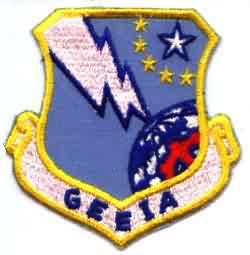 |
What Was GEEIA And What Happened To It?MSgt Harvey Hartman272nd EIS, TxANG LaPorte, TX |
 |
What Was GEEIA And What Happened To It?MSgt Harvey Hartman272nd EIS, TxANG LaPorte, TX |
Many visitors to the Radomes web site have seen references to GEEIA and wonder what it means. GEEIA stood for Ground Electronics Engineering Installation Agency and was the Air Force component that was responsible for the engineering and installation of fixed (ground-based) electronics systems throughout the USAF during the 1960s and 70s. This included many of our revered AC&W sites. GEEIA was composed of AF electronics personnel (predominately Keesler-trained Radio and Radar maintenance troops like you and me), cable and construction troops, and support functions such as management, engineering, drafting, supply, etc. GEEIA was equipped with the manpower and equipment for worldwide tasking.
When a radar site was constructed and new radar equipment was to be installed, the equipment manufacturer was usually tasked as part of their original sales contract to install it. GEEIA was responsible for the coordination and oversight of the overall project and GEEIA personnel usually installed the smaller systems associated with such a project; i.e. comm radios and antennas, telephones, some ops darkroom equipment, etc. However, if used/overhauled (oops, I mean Previously Owned) equipment was provided by AF equipment depot for installation at the new site (and this was often the case when a dismantled site was reinstalled somewhere else) GEEIA was usually the installing workforce. GEEIA also performed heavy repairs, modifications, replacements and removals.
GEEIA`s roots can be traced as far back as 1901 when MG Adolphus Greely, Chief of the Army Signal Corps, sent Lt Billy Mitchell to string 1400 miles of telegraph cable across Alaska. In November 1938, the Army Airways Communication System (AACS) was organized and this became the Army Airways Communication System Wing in April 1943. In July 1943, this Wing was reassigned directly under the Army Air Forces. With the conversion of the Army Air Force into the US Air Force in 1947, communications installations units were organized into five Installations and Maintenance (I&M) Squadrons. These were located in Oklahoma, Germany, Newfoundland, Alaska and Japan.
Throughout the 1950s, the USAF was in its infancy and much of its infrastructure was still being converted from WWII era Army Air Corps Flying Fields into Air Force Bases. Also, the Cold War was rapidly gaining momentum and public hysteria over the H-bomb created the urgent need for a stronger national defense. This, of course, was the birth of the Arms Race between the superpowers. As a result, in 1958 Air Force Chief of Staff General Curtis LeMay reshaped the I&M Squadrons into a larger and more organized workforce capable of managing the rapidly increasing USAF communications workload. This new workforce was named GEEIA and was headquartered at Griffiss AFB, NY. In the 1960s, GEEIA`s workload increased by leaps and bounds as the Cold War escalated and dictated greater and greater communications capabilities for our military. GEEIA became a massive empire as it built the USAF into what it is today.
However, once the communications structure was in place, the need for new communications installations was reduced and most workload then involved performing upgrades to the existing communication system. The large GEEIA workforce could no longer be justified and in 1970, due to budget constraints, GEEIA was cut drastically and merged into the Air Force Communications Service (AFCS.) This merged organization handled the installation and maintenance tasks that GEEIA had previously performed. AFCS became the Air Force Communications Command (AFCC) in 1979 and a new Engineering and Installation Center (EIC) was established at Tinker AFB in Oklahoma City in June 1981. Functions previously performed by GEEIA were spread among a multitude of active duty AF and Air National Guard Engineering and Installation (E&I) Squadrons that EIC managed: The 738th EIS was located at Keesler AFB in Biloxi, the 838th was at Kelly AFB in San Antonio and the 938th was at McClellan AFB in Sacramento. These three active duty squadrons managed 19 ANG E&I Squadrons.
During the early 1990s, widespread base closures and restructuring eliminated the 838th and 938th leaving the 738th EIS as the sole liaison between the active duty AF and the ANG E&I Squadrons. Base closures are becoming routine these days, as the American public, who once demanded that the military be increased to protect the US against atomic attack, now wants the military cut back to a more affordable size. While most of us hate to see our military shrink to a smaller force (some call it a "leaner and meaner force") truth is that we simply don`t need such a giant money-absorbing military now that we have determined that the Soviets no longer want to attack us for our Levi`s jeans.
E & I Squadrons: Today, E&I Squadrons are responsible for installing, relocating, modifying, or removing communications systems throughout the USAF, both stateside and overseas. With the frantic pace of advancements in digital technology over the past twenty years, we now have smaller and more reliable communications systems that do not require large teams several weeks or months to install. Additionally, our modern deployable USAF has turned toward more mobile systems and fewer bolted-to-concrete systems. All of this has helped to reduce the mighty GEEIA Empire to the leaner and meaner E&I that it is today.